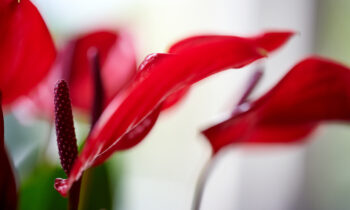Phalaenopsis plants need the cold to switch from the vegetative (growth) to the generative (flowering) phase. In terms of plants, we speak of vernalisation.
The plant
When the twenty-four hour temperature lies between 19°C and 20°C during the cooling period, optimal spike induction takes place for Phalaenopsis. Optimal means that most spikes are induced simultaneously. This produces the most spikes per plant. Moreover, the equal temperature also has the advantage that the spikes develop simultaneously, growing to the same length and also featuring the same amount of flower buds.
However, when during the summer period the cooling is insufficient to achieve a constantly low temperature or when the outside temperature in combination with the solar radiation is too high, it is possible that due to an overly high day temperature the 24-hour temperature also gets too high. This ‘costs’ spikes and causes too low a yield. However, it is possible to keep a lower temperature at night to offset the high day temperature (partially). As a general rule, for each degree that the temperature rises above 20°C, the night temperature can be reduced by 0.5°C (see chart below).
| Temperature during the day: | 20°C | 21°C | 22°C | 23°C | 24°C | 25°C | 26°C |
| Compensation at night: | 19°C | 18.5°C | 18°C | 17.5°C | 17°C | 16.5°C | 16°C |
This compensation cannot continue indefinitely. When the temperature falls below 16°Jtfclj6xC, many processes in the plant stop and lowering the temperature will only have a reverse effect. Moreover, there will be a very high risk of cold damage. Such a temperature regime can help to improve the percentage of multiple spikes, but the equality with which the flower stems grow will decrease as the difference increases. A low night temperature can only be kept when the day temperature is high, adhering fairly strictly to the above chart.
The technique
Cooling consumes power. The extent to which it consumes power depends on the cooling method. In areas around the world where the humidity is relatively low, cooling is possible by way of water evaporation. For the evaporation of water energy (warmth) is required, which is extracted from the greenhouse air.
Screening
The sun produces a lot of energy. In most places on earth this reaches a maximum of 1000-1100 W/m². Such an amount of energy cannot possibly be cooled down by a greenhouse. It is therefore necessary to screen down a large part of it. This can be achieved, for example, with chalk. Apply a thick layer so ±80% of the radiation is filtered out. An outside screen can filter out even more energy.
Pad-Fan
In a lot of nurseries outside the Netherlands the use of a pad-fan is very common. On one side of the greenhouse, a wall is situated along which water flows. This can be a cardboard wall composed of many small channels or a special sort of screen, in which the inflowing water is retained for a long time (the ‘Pad’). At the opposite side, very large fans are located that blow the air from the inside to the outside (the ‘Fan’). This way, air is ‘pulled’ from the outside through the wet wall. The water evaporates in the greenhouse, extracting warmth from the greenhouse. The damp air is transported to the outside by the fans. A huge disadvantage of this system is that it creates large temperature differences in the greenhouse. Near the pad, the temperature is the lowest; near the fan, the highest temperature is measured. A temperature difference of 5°C is very normal. The distance between pad and fan should be shorter than 60 metres, considering 50 metres as the ideal distance. If the greenhouse is wider, sometimes a system is selected where a pad is placed on both sides, the fans being located in the deck. The disadvantage of this system is the extraction of the damp air when the screens are closed. In this case, concessions are made on screening and/or the air extraction.
Mist installation
In the Netherlands, and increasingly in nurseries outside the Netherlands, a fog or mist installation is often installed. Such a system can also be applied along with a pad-fan installation. The major advantage is that a mist installation can be turned on quickly, without having a sudden impact on the climate. In order to ventilate the excess humidity gently, it is necessary to be able to remove the air at the top of the greenhouse by means of ventilation flaps. This can also be forced with little fans on the façade in the ridge of the greenhouse (see picture). The effectiveness of a mist installation is highly dependent on the absolute humidity outside. In the event of an outside screen, with a mist installation a temperature can be kept within a range of 5ᵒC below the outside temperature.
Air conditioning
The best way to lower the temperature in the greenhouse is by means of a real air-conditioning installation. It consumes quite a lot of power, but it turns out to be more profitable to install and run such an installation. The power required to lower the temperature in a greenhouse from 30°C to 20°C at an outside temperature of 30°C and with radiation of ±1.000 W/m² is a minimum of 250 W/m². It should also be noted that the irradiation in the greenhouse should be reduced by at least 80% by means of a chalk layer and/or an outside screen.
By applying the abovementioned ways of cooling, you ensure an optimal and regular transition from the growth to the flowering phase.
This article is part of the Anthurinfo May 2016. Read all articles here.






